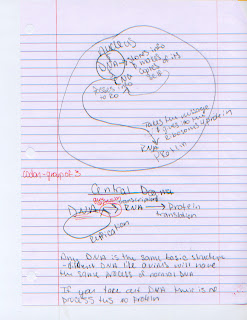DNA we have all seen it and tried to figure out what shape it was and what it is well I have an answer for this question.. DNA has a shape of a double helix which basically is like a twisted ladder. DNA is the genetic material in your body. DNA has four different types of nucleotides two are purine bases (A-adenine and G-guanine) and the last two are pyrimidine bases(T-thymine and C-cytosine). Since DNA is a twisted ladder each purine has a pair: A=T and G=C this is because of hydrogen bonds!!!!
The picture above is an example of DNA but it is flat to show the bonds. In class we did the same activity of building DNA but it looks like the picture above.
After wer learned about DNA we started on Central Dogma. Central Dogma is DNA->RNA->Protein translation. The arrow between DNA and RNA is called transcription. This is where the DNA just passes info to RNA. RNA to Protein translation is where it takes the message and gives it to the Ribosomes for protein.
Any DNA is the same basic structure. Different DNA like a virus will have the same process of normal DNA. If you take out DNA their is no process thus no Protein.
 |
| This is a picture of notes I took on Central Dogma. |
This is a vocabulary project about central dogma.
From DNA to Proteins: Key Terms
(Ch. 14 in the Mader Biology Textbook)
Read about and define the terms below. Develop and publish a concept map, flashcard set, or other creative visual aid to help yourself and others learn the connections between these ideas.
Anticodon: Three-base sequence in a transfer RNA molecule base that paris with a complementary condon in mRNA.
Codon: Three-base sequence in messenger RNA that causes the insertion of a particular amino acid into a protein, or termination of translation.
Exon: A segment of a DNA or RNA molecule containing information coding for a protein or peptide sequence.
Genetic Code: Universal code that had existed for eons; specifics protein synthesis in the cells of all living things. Each condon consists nucleotides that make up one of the 20 amino acids found in proteins.
Intron: A segment of a DNA or RNA molecule that does not code for proteins and interrupts the sequence of genes.
mRNA (messenger RNA): Type of RNA formed from a DNA template and bearing coded information for the amino acid sequence of a polypeptide.
Promoter: In an operon, a sequence of DNA where RNA polymerase binds prior to transcription.
Protein-coding Gene: Coding Gene Transcribes into mRNA.
Ribonucleic Acid (RNA): Nucleic acid produced from covalent bonding of nucleotide monomers that contain the sugar ribose; occurs in three forms: messenger RNA, ribosomal RNA, and transfer RNA.
RNA polymerase: During transcription, and enzyme that joins nucleotides complementary to a DNA template.
rRNA (ribosomal RNA): Type of RNA found in ribosomes that translate messenger RNAs to produce proteins.
Transcription: It is the process of transcribing or making a copy of genetic information stored in a DNA strand into a complementary strand of RNA (messenger RNA or mRNA) with the aid of aRNA polymerases.
Translation: Process whereby ribosomes use the sequence of codons in mRNA to produce a polypeptide with a particular sequence of amino acids.
tRNA (transfer RNA): Type of RNA that transfers a particular amino acid to a ribosome during protein synthesis; at one end, it binds to the amino acid, and at the other end it has an anticodon that binds to an mRNA codon.

No comments:
Post a Comment